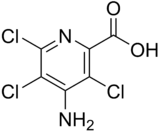
Back بايكلورام Arabic پیکلورام AZB Picloram German پیکلورام Persian Pikloraami Finnish Picloram Galician Picloram Italian Picloram Dutch Pikloram Polish Picloram Portuguese
 | |
 | |
| Names | |
|---|---|
| Preferred IUPAC name
4-Amino-3,5,6-trichloropyridine-2-carboxylic acid | |
| Other names
Picloram
Tordon Grazon | |
| Identifiers | |
3D model (JSmol)
|
|
| Abbreviations | ATCP |
| ChEBI | |
| ChEMBL | |
| ChemSpider | |
| ECHA InfoCard | 100.016.034 |
| KEGG | |
PubChem CID
|
|
| UNII | |
CompTox Dashboard (EPA)
|
|
| |
| |
| Properties | |
| C6H3Cl3N2O2 | |
| Molar mass | 241.45 g·mol−1 |
| Appearance | colorless to white crystalline solid[1] |
| Odor | chlorine-like[1] |
| Melting point | 218.5 °C (425.3 °F; 491.6 K) decomposes |
| 0.04% (20°C)[1] 430 mg/L at 25 deg C[2] | |
| Vapor pressure | 0.0000006 mmHg (35°C)[1] |
| Hazards | |
| NIOSH (US health exposure limits): | |
PEL (Permissible)
|
TWA 15 mg/m3 (total) TWA 5 mg/m3 (resp)[1] |
REL (Recommended)
|
none established[1] |
IDLH (Immediate danger)
|
N.D.[1] |
Except where otherwise noted, data are given for materials in their standard state (at 25 °C [77 °F], 100 kPa).
| |
Picloram is a systemic herbicide used for general woody plant control. It also controls a wide range of broad-leaved weeds, but most grasses are resistant.[3] A chlorinated derivative of picolinic acid, picloram is in the pyridine family of herbicides.
Picloram can be sprayed on foliage, injected into plants, applied to cut surfaces, or placed at the base of the plant where it will leach to the roots. Once absorbed by the foliage, stem, or roots, picloram is transported throughout the plant.
Herbicides containing picloram are sold under a variety of brand names. Dow Chemicals and now Dow AgroSciences sell herbicides containing it under the brand name Tordon.[4]
During the Vietnam War, picloram and other herbicides were combined to make Agent White (commercially available as Tordon 101) and enhanced Agent Orange, which was previously conducted by the British military during the Malayan Emergency. Large quantities of these herbicides were sprayed by U.S. forces in areas where they considered its long-term persistence desirable, such as inland forests.[5] In 1974, 413,000 pounds (187 t) of picloram were used in the US, mainly by government and industry.[6]
- ^ a b c d e f g NIOSH Pocket Guide to Chemical Hazards. "#0514". National Institute for Occupational Safety and Health (NIOSH).
- ^ "Picloram".
- ^ Picloram Pesticide Information Profile, Pesticide Management Education Program, Cornell University.
- ^ Stanley A. Greene (2005). Sittig's Handbook of Pesticides and Agricultural Chemicals. William Andrew. p. 717. ISBN 978-0-8155-1903-4.
- ^ Committee to Review the Health Effects in Vietnam Veterans of Exposure to Herbicides; Institute of Medicine (1994). Veterans and Agent Orange: Health Effects of Herbicides Used in Vietnam. National Academies Press. pp. 89–90. ISBN 978-0-309-55619-4.
- ^ "Pesticide Usage Survey of Agricultural, Governmental, and Industrial Sectors in the United States, 1974". epa.gov. EPA. 1977.